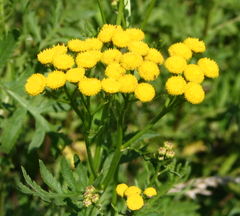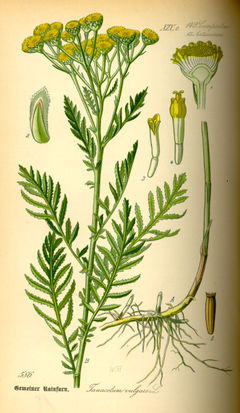Tansy
2008/9 Schools Wikipedia Selection. Related subjects: Plants
| Tansy | ||||||||||||||
|---|---|---|---|---|---|---|---|---|---|---|---|---|---|---|
 |
||||||||||||||
| Scientific classification | ||||||||||||||
|
||||||||||||||
| Binomial name | ||||||||||||||
| Tanacetum vulgare L. |
Tansy (Tanacetum vulgare) is a perennial herbaceous flowering plant of the aster family that is native to temperate Europe and Asia. It has been introduced to other parts of the world and in some cases has become invasive. It is also known as Common Tansy, Bitter Buttons, Cow Bitter, Mugwort, or Golden Buttons.
Description
Tansy is a flowering herbaceous plant with finely divided compound leaves and yellow, buttonlike flowers. It has a stout, somewhat reddish, erect stem, usually smooth, 50-150 cm tall, and branching near the top. The leaves are alternate, 10-15 cm long and are pinnately lobed, divided almost to the centre into about seven pairs of segments or lobes which are again divided into smaller lobes having saw-toothed edges, thus giving the leaf a somewhat fernlike appearance. The roundish, flat-topped, buttonlike, yellow flower heads are produced in terminal clusters from mid to late summer. The scent is similar to that of camphor with hints of rosemary. The leaves and flowers are said to be poisonous if consumed in large quantities. The plant's volatile oil is high in thujone, a substance found in absinthe that can cause convulsions. Some insects, notably the tansy beetle, have evolved resistance to tansy and live almost exclusively on it.
History and distribution
Tansy is native to Eurasia; it is found in almost all parts of mainland Europe. It is absent from Siberia and some of the Mediterranean islands. The ancient Greeks may have been the first to cultivate it as a medicinal herb. In about 1525, it was listed (by the spelling "Tansey") as "necessary for a garden" in Britain.
Toxicity
Tansy contains volatile oils which can cause contact dermatitis in sensitive individuals and, if taken internally, result in toxic by-products being produced in the liver and digestive tract as the plant's oils are broken down. Tansy is highly toxic to internal parasites, and has been used by herbalists to expel worms for centuries. Because tansy contains thujone, the U.S. FDA limits tansy use to alcoholic beverages, and the final product must be thujone-free. Tansy is an effective insecticide, and is highly toxic to arthropods.
Culinary uses
Tansy was formerly used as a flavoring for puddings and omelets, but is almost unknown now. It was certainly relished in days gone by, for Gerarde speaks of them as "pleasant in taste", and he recommends tansy sweetmeats as "an especial thing against the gout, if every day for a certain space a reasonable quantitie thereof be eaten fasting". In Yorkshire, tansy and caraway seeds were traditionally used in biscuits served at funerals. According to liquor historian A. J. Baime's book Big Shots, Tennessee whiskey magnate Jack Daniel enjoyed drinking his own whiskey with sugar and crushed tansy leaf.
Ethnomedical use
For many years, tansy has been used as a medicinal herb. Irish folklore of the mid-1800s suggests bathing in a solution of tansy and salt as a cure for joint pain. Bitter tea made with the blossoms of T. vulgare has been effectively used for centuries as an anthelmintic (vermifuge). Tansy cakes were traditionally served during Lent because of a superstition that eating fish during Lent caused intestinal worms. Note that only T. vulgare is used in medicinal preparations; all species of tansy are toxic, and an overdose can be fatal. The dried flowering herb of Tanacetum is used ethnomedically to treat migraine, neuralgia, and rheumatism, and as an antihelminthic, in conjunction with a competent herbalist to circumvent any possible toxicity. Formerly, tansy was often used for its emmenagogue effects, but rumors have implicated tansy in cases of miscarriage. Pregnant women should avoid this herb.
Other uses
In England, bunches of tansy were traditionally placed at windows to keep out flies. Sprigs were placed in bedding and linen to drive away pests.
Tansy has been used throughout many Melbourne gardens and homes to keep away ants.
It is also used by some traditional dyers to produce a golden-yellow pigment. The yellow flowers are dried for use in floral arrangements.
Tansy is also used as a companion plant, especially with cucurbits like cucumbers and squash, or with roses or various berries. It is thought to repel ants, cucumber beetles, japanese beetles, squash bugs, and some kinds of flying insects, among others.
Tansy in art and literature
- A portion of a nineteenth-century poem by John Clare describes the delight of tansy and other herbs:
And balm, and mint, with curl'd-leaf parsley grew,
And double marigolds, and silver thyme,
And pumpkins 'neath the window climb;
And where I often, when a child, for hours
Tried through the pales to get the tempting flowers,
As lady's laces, everlasting peas,
True-love-lies-bleeding, with the hearts-at-ease,
And golden rods, and tansy running high,
That o'er the pale-tops smiled on passers-by.
- From "The Cross Roads; or, The Haymaker's Story", available from a collection at Project Gutenberg.
- Tansy Strange, a character in The Jem Star by Karen Drury, is named after this wild herb. The name is very appropriate due to her wild character.
